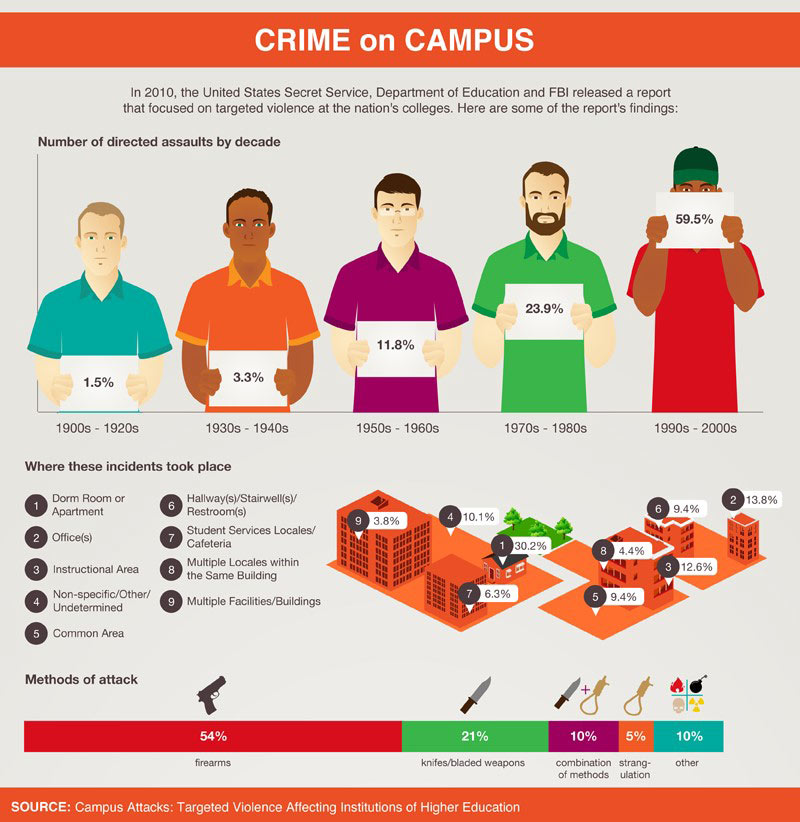This brief guide shows exactly how you can save the people for whom you are responsible.
Your personal team can be heroes or scapegoats. Preparation for an emergency is essential and a strong communication plan is the backbone. Please read and implement this guide, make adjustments for your situation, then feel free to share it with your appropriate staff.
The morning of April 16, 2007 in Blacksburg, Virginia a senior at Virginia Tech launched one of the deadliest shooting attacks in U.S. history. Before he turned the gun on himself, he killed 32 people and wounded 17 others. It was a tragedy that shocked the nation and had everyone talking about issues like gun control, privacy laws, identifying mental disorders in students, and breaches in campus security. The emergency response was swift, but the nature of the attack prevented law enforcement from being able to stop it before so many lives were tragically lost.
Sadly, this wasn't an isolated incident. There has been a rash of deadly attacks on college campuses since then, heightening the discussion about how to reduce the threats and how to strengthen emergency preparedness, not just for shootings but other credible threats that are on the rise. (Nearly one in five college female freshmen have reported being a victim of rape or attempted rape.)
It's increasingly important for campuses to be aware of these new dangers and prepare for emergency situations. Campuses have to negotiate their security more than ever before, and larger campuses have even greater challenges keeping the channels of communication effectively open while implementing more widespread and complex systems.

Internal Communication Methods
Communication within the campus community is critical during an emergency situation to keep everyone on the same page to comprehend what is happening, where the danger is, and what to do.
There are various methods of communication that campuses can use to respond to or prevent a crisis.
- A siren system is an effective way to sound an alarm to rapidly and acutely grab everyone's attention after an attack. This mode of communication is not without its challenges though. You can risk not reaching the hearing impaired, those who are in a deep sleep (perhaps after a night of binge drinking), or those who may be listening to loud music or music on headphones.
- Since most students and faculty are connected to the internet, sending out an email alert is a good way to quickly deploy a widespread, detailed message or directing students to an emergency website. Social media channels can also spread a message quickly.
- The telephone is obviously one of the most common tools used to communicate. Setting up a university emergency line for people to call in for information is a good way to get the word out. Also, pushing out campus-wide text or voicemail messages is more immediate and ensures that more people will have access to the emergency alert. Setting up a telephone tree network would work for smaller campuses as a backup system should something happen to the established alert system. Of course, telephone and cellphone communication won't function if the power is shut down or reception is lost due to an interference with the cellphone tower.
- Pager systems are less common these days, but their simplicity, reliability, and affordability are the advantages of providing this communication system.
- Larger schools may have a student run cable TV station that can broadcast to campus dormitory televisions, but won't be a solution if the university loses power or the signal is interrupted.
- Campus safety announcements broadcast from emergency or security vehicles is a good if there isn't a signal system on the campus. This is an effective way to get an alert out to students who may be just off campus or away from devices that might relay a warning. Delivering messages through the campus radio if there is a college radio station is another communication outlet, but has limited reach and may not be effective if the signal is disrupted or the power goes down.
- Two-Way Radios offer an invaluable solution in the coordination of emergency support efforts. When phone lines are tied up and confusion abounds through other communication channels, or even if the power is down, the communication nature of two way radios, effectively facilitating a communication channel that exists independently of other communication outlets. When other means of contact prove to be ineffective or tied up with those searching emergency information, emergency responders can use these to facilitate a conversation effectively in a group. Emergency personnel can relay detailed and targeted information and filter out chaotic noise that may impede the emergency efforts. Conventional two way radios operate on one channel at a time, while the trunked system automatically picks the physical radio frequency channel and users carry simultaneous conversations privately on one channel.
- Students can also tap into a "ham" radio channel. This is designated radio frequencies for amateur two-way radio hobbyists who must pass a short and simple exam to acquire a license to use them.
External Communications
Communication to the world beyond the campus perimeter during a crisis situation is also an important factor. Looping in families, loved ones, and also the media is crucial to help control the situation.
Telephones are the main source of communication, but they can become clogged with people trying to seek information and can very easily break down in a disastrous event. Internet outreach can effectively provide information, but systems can break down or become quickly cluttered with false or confusing reports. TV and radio transmissions have the largest and most immediate reach to the public. It's important for colleges and universities to have a public relations plan in place to get as much detailed and accurate information to the media as quickly as possible to circumvent confusion and panic.
Coming up with an emergency plan before a crisis happens is essential. Creating an emergency task force to discuss various emergency scenarios and solutions is key. Because emergencies happen unexpectedly and risks present themselves in ways that are difficult to fathom, flexibility and adaptability of emergency plans should be framed around the process. Continually updating and perfecting the plan should also be a part of the strategy. When coming up with preparation lists, incorporating questions about what is needed before, during and after an emergency is an important tactical approach. Often the mere act coming together to develop a plan is more valuable than the plan itself.
Communication is key. We're getting smarter as the risks on campuses increase. We are more connected than ever before with more systems that are helping us stay connected. It's important to examine every communication channel to assess how they can all work together for the protection of all effected by an unexpected crisis. Employing multiple communication outlets to keep everyone in the loop,
To find more information on developing and implementing a plan, check Ready.gov.
